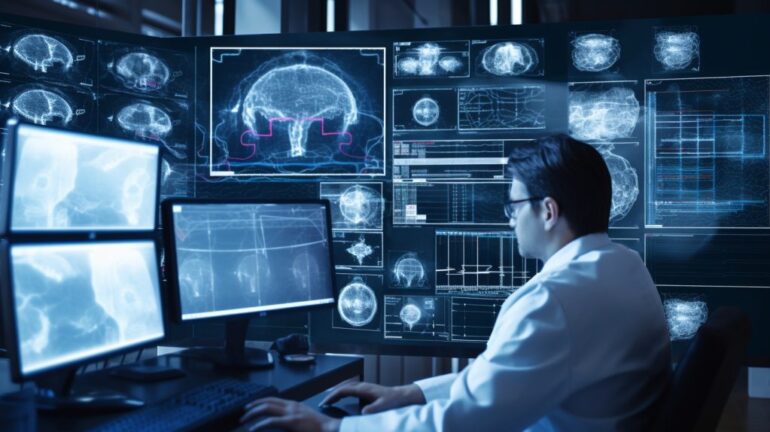TL;DR:
- AWS and Hoppr collaborate to unveil Grace, a cutting-edge foundation model for medical imaging.
- Grace facilitates faster development of AI solutions tailored for medical image analysis.
- Health2047, the American Medical Association’s venture studio, invests multi-million dollars in Hoppr.
- Grace enables image-to-image and text-to-image learning across various medical imaging modalities.
- It provides diagnostic, clinical, and operational insights from medical imaging data.
- Grace can expedite AI solution development, reducing developers’ time to market.
- Hoppr exclusively builds Grace on AWS, leveraging Amazon SageMaker’s capabilities.
- AWS’s expertise in medical imaging technology solidifies its role as a key partner.
Main AI News:
In a groundbreaking partnership, AI startup Hoppr has joined forces with AWS to introduce a cutting-edge foundation model aimed at accelerating the integration of generative AI solutions within the field of medical imaging. The momentous announcement took place at RSNA 2023, the prestigious annual radiology and medical imaging conference held in Chicago.
This innovative product, aptly named “Grace,” is meticulously crafted as a B2B model, meticulously designed to empower application developers to construct superior AI solutions tailored for medical image analysis, all while expediting the development process. Alongside the unveiling of Grace, Hoppr disclosed a substantial “multi-million dollar investment” infusion from Health2047, the esteemed venture studio of the American Medical Association.
Hoppr, headquartered in Chicago and established in 2019, has successfully secured $4.1 million in funding to date, according to CEO Khan Siddiqui. It’s worth noting that the pioneering computer scientist Grace Hopper serves as the inspiration behind both the company and its remarkable new product.
The foundational model is engineered to enable “image-to-image and text-to-image learning” across a diverse array of medical imaging modalities, as articulated in Hoppr’s official press release.
Siddiqui elaborated, “Grace is trained on an extensive dataset that empowers the foundation model to grasp the nuances across various imaging modalities and radiology reports. Through the use of embedding and vectors derived from image training, Grace adeptly maps and correlates identical findings across different modalities. This allows Grace to seamlessly illustrate how a nodule detected in an x-ray would manifest in a CT scan, for instance.”
Remarkably, this model boasts the capability to offer diagnostic, clinical, and operational insights gleaned from medical imaging data. For instance, Grace can promptly alert users to the necessity for additional diagnostic imaging right at the point of care. Moreover, the model can generate findings from an image, serving as a preliminary report that can be reviewed and finalized by clinicians.
Furthermore, this revolutionary tool extends its utility to interventional neurologists, facilitating more precise procedural planning. Siddiqui highlighted, “Medical professionals can engage in meaningful dialogues with medical imaging studies, seeking clarifications regarding findings, exploring alternative imaging perspectives, inquiring about treatment protocols, and obtaining recommendations for surgical interventions.”
Presently, Grace is accessible through an API service, strategically positioned to cater to application developers. Hoppr envisions a future where these developers harness the model’s capabilities to create products that enhance the engagement of radiologists, technicians, and other healthcare staff with medical images, thereby optimizing patient care.
One of the most notable advantages of Grace lies in its potential to expedite AI solution development. Siddiqui emphasized that the conventional approach to application development, involving supervised learning, necessitates meticulous annotation of each image, consuming a year or more of effort. However, with Grace, developers can fine-tune their models and reach the market in a matter of weeks.
Hoppr’s unwavering commitment to excellence is epitomized by the exclusive development of Grace on AWS using Amazon SageMaker, the tech behemoth’s acclaimed machine learning platform designed to facilitate the creation and deployment of cloud-based AI models. Siddiqui commended AWS for its unparalleled technological prowess, robust data storage capabilities, and scalability, asserting that it provides the ideal ecosystem for Hoppr’s groundbreaking endeavors in the realm of medical imaging.
In Siddiqui’s own words, “The company’s natural and deep understanding of medical imaging is unparalleled,” cementing AWS as an indispensable partner in this monumental venture.
Conclusion:
The introduction of “Grace” by Hoppr and AWS marks a significant leap forward in the integration of generative AI solutions in medical imaging. This innovation has the potential to revolutionize how medical professionals engage with imaging studies, enhance patient care, and streamline AI solution development, ultimately shaping the future of the medical imaging market.

